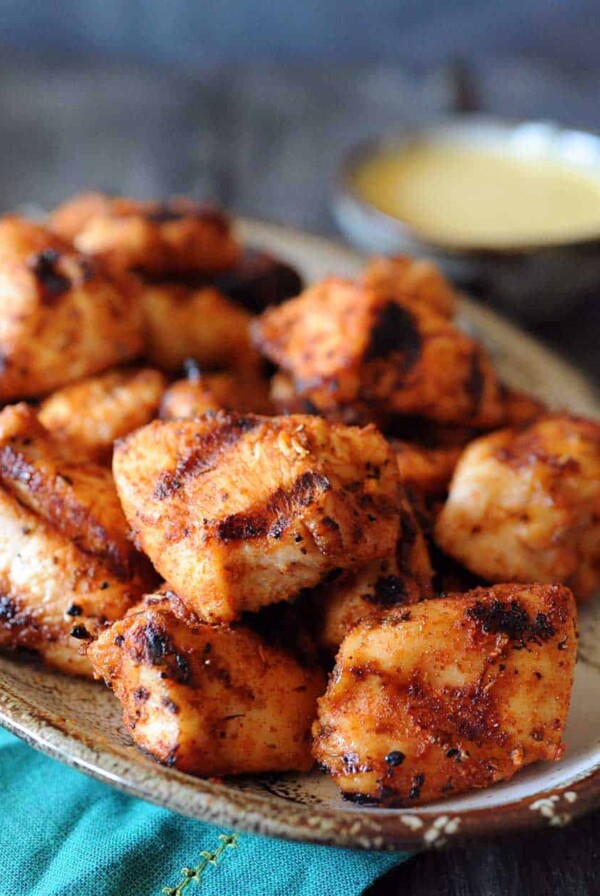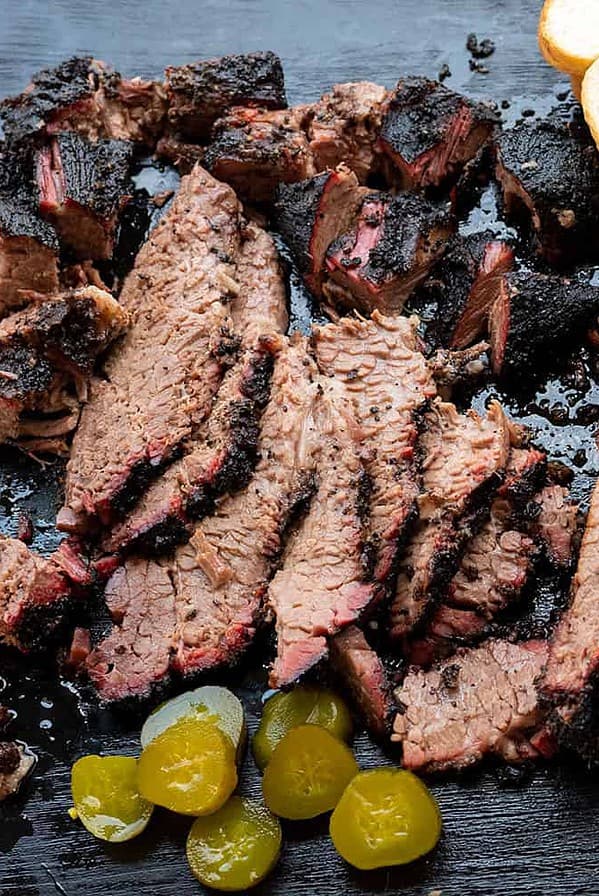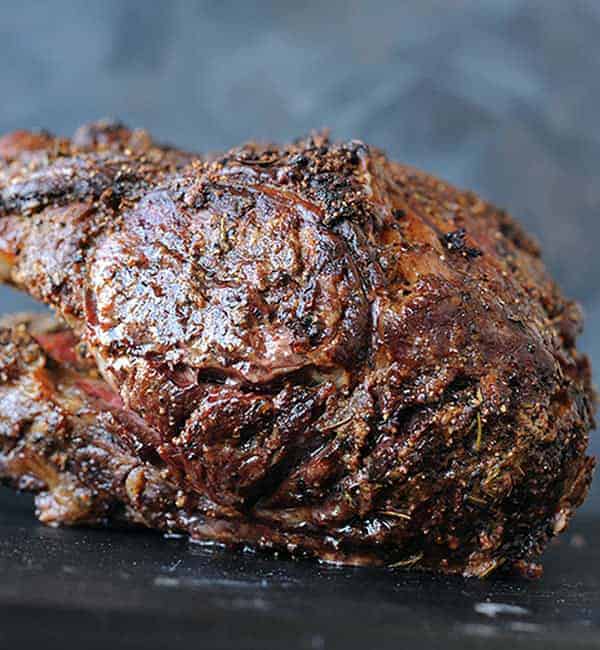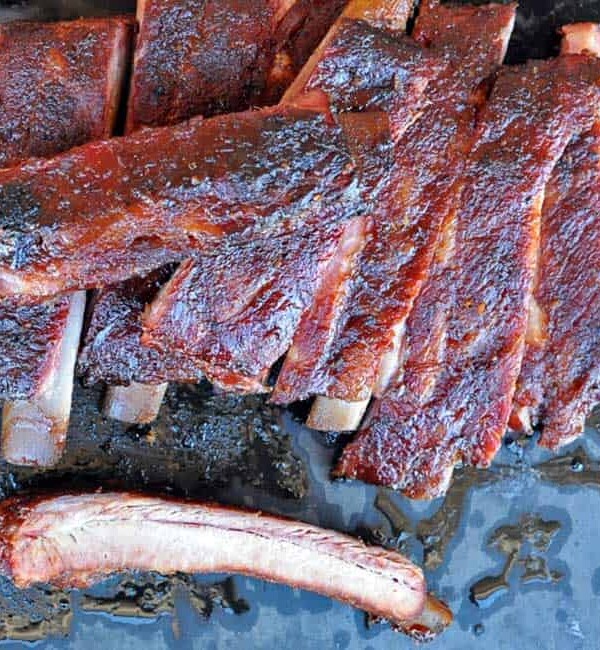Christie has two big BBQ competitions coming up, so this week she’s sharing how she preps the week before a competition and what she includes on her competition BBQ checklist.
Competition season is in full swing for me. Next weekend, I’ve got a KCBS competition in Yuma, Arizona, and then in March, I’ve got a competition at the SCA World Championships where I’m competing in the ancillary category.
So for this week’s BBQ Tips podcast, I thought I’d touch on my competition timelines and my barbecue checklist.
Listen to the BBQ Tips Podcast on
Table of Contents
Competition BBQ timelines before the big day
First, I’m going to start with my timelines, especially related to a KCBS competition.
So for those who don’t know KCBS competitions usually start on a Friday, and then the competition and turn ins are on Saturday.
Monday before a competition
So my timeline usually starts on about Monday. That’s when I’m sourcing all of the meats except for my brisket. I always order my brisket from Snake River Farms. I use a wagyu gold 18-20-pound brisket. (use code GIRLSCANGRILL to save 10%).
I usually like to order that about two weeks in advance. It does come frozen, so I leave it in the refrigerator and let it thaw all the way up until I trim it for the competition. Everything else, I usually buy on Monday. For my pork, I usually use Hormel pork butts and Hormel pork ribs.
And then for my chicken, I usually get Sanderson Farms chicken. I usually cook thighs. I’ve tried legs. Haven’t been too successful with those, so I just stick to the thighs.
But I buy all my meat on Monday and it sits in the fridge.
Tuesday before a competition
Then on Tuesday, this is where I’m a little bit OCD. This is when I go through my full timelines for every meat category.
I look at my competition from the time before, and I look at my notes because every time I’m competing in the middle of my competition, I’m actually writing down what’s going well, what’s not going well.
Then, I compare that with the scores that I get from the judges. So the Tuesday before competition, I go back and I look at those timelines. I look at all the notes that I made, and I make decisions if I want to make any adjustments.
An example of a recent adjustment, I’ve been toying around with brining my chicken thighs. When I competed in Indio, my chicken thighs were crap. I think I was like second to last, which is the worst I’ve ever done in chicken. But that’s because I brined it too long.
So I’m always experimenting and learning as I go. I’m a little more unique than some cooks. A lot of cooks will practice, practice, practice. And so they’re really honed when they get to competition.
I have a tendency to just experiment on the fly at a competition. I just don’t have the time to always practice. So I test things out when I get to the competition.
So in Indio, I did the brine again. I did it too long. My chicken skins were rubbery even though I scraped them. So that was a big X on my timeline reminding me not to do that again, at least not for 4 hours.
My notes can have everything from “I should have let the meat cook longer. I let it cook too long. The seasoning was too spicy or too peppery. Maybe I needed to be more liberal. Or maybe I ended up adding a pop of finishing rub at the end.” All of those details I’m writing down any shifts in time, which happens a lot with altitude.
Sometimes, my time of my cooks will change, but I’m writing all those notes down.
Then I also have a full spreadsheet of all of my scores, and I look at that too. So if I got sevens or eights in taste, which I usually don’t get sevens, but sometimes it happens. But if I get those in taste, then I evaluate and I say, “was that just this competition? Or have I been consistently getting 8s on my taste?”
And if that happens, then I make a decision of what do I maybe need to change?
Unfortunately, we don’t always get comment cards. Most of the time we don’t get comment cards, so we don’t know if it was too spicy, too sweet, too bland, too whatever.
We just have to kind of guess if they don’t give us a perfect score, what was it that they maybe didn’t like about it? Which is why I take so many of my own personal notes, and I have my friends and family taste my turn ins so that way they can tell me what they liked or didn’t like about it.
I look at my scores, I look at my notes, and then on Tuesday, that’s when I’m updating my timelines.
Wednesday before a competition
Wednesday is usually my trim day.
That’s when I pull all the meat out of the refrigerator and I trim it up. I get my chicken thighs and I scrape all the skins off and I butcher them and manipulate them until they’re perfect little pillows.
I slice my ribs down to like nine to eight bones, and I cut my pork down pretty aggressively to mainly just money muscles and bacon.
And then I separate my brisket point and my brisket flat.
Then I put those all in vacuum seal bags or Ziploc bags, and I throw them in the refrigerator until the competition
On Wednesdays, I’m also preparing my brines, injections and sauces and usually with that the sauces get fully premixed and put in the refrigerator. But for the injections and the brines, those, I just mix the powder contents and I put those in the shaker bottle.
Then, come competition time when I actually get on site, that’s when I add my water or liquids or other things to them. I don’t actually mix them in advance. I just mix the dry ingredients because I don’t want the phosphates that are in those mixtures to be introduced to any liquids until right before I need them.
Thursday before a competition
So by Thursday, I’ve got my meat trimmed, I’ve got my injections made, I’ve got my timelines and recipes and everything all printed out.
So Thursday is my packing day. I load my Dune Sport Trailer up with everything that’s on my checklist, everything that’s on my packing list, which I’m going to go through some of that shortly.
I make sure that everything’s in my trailer on Thursday so that when we wake up Friday morning, all we have to do is load the meat that’s from the refrigerator to my Cambro, load our toiletries and just get ourself on the road.
The Friday of competition
Most of my competitions are pretty close. If they’re within a five-hour radius, I’m leaving on Friday. If, however, they’re a little bit further away, like Ogden, Utah, which is about eight hours, we will leave on a Thursday.
So I adjust my timeline slightly. But for the most part, we usually leave about Friday morning, get to the competition by Friday afternoon, get parked, get set up.
That’s when I then mix my injections and I start my full timelines.
I actually do my cook on Saturday, so I don’t have to light my pits until early, early Saturday morning. But then that’s when the competition begins and we get rolling. And then by 4-5 p.m., it’s awards time. Then, we’re packing up and headed home.
After the competition
On my drive home, I review all the notes that I took from that competition. And I look at all my scores. I enter them into my spreadsheet so that when it’s time for another competition, all that information that was fresh in my head is written down. That way, I can make any adjustments that I want for the next competition.
What you need on your competition BBQ checklist
One of the most important things that I tell people when they’re interested in competition barbecue is you’ve got to create a barbecue checklist, which includes a packing list, and then also all of your timelines.
I know you can probably barbecue. Great, and that’s awesome, but when it comes to having to pull together four meats and turn them in in 30 minute windows, and then you’ve got the distractions of the competition and the other teams. You’ve got the distractions of people coming by your tent who want to talk to you and ask you questions and ask you how you do this and how you do that, it’s really easy to skip a step.
Just the slightest little slip up can mess up your meat, and mess up your game, mess up your timeline, and then you can be off course. So I strongly, strongly recommend creating a barbecue checklist and creating timelines for each of your recipes.
I want to talk to you about what my barbecue checklist looks like. It’s broken down to a few different areas.
Checklist for the grill area
This probably seems pretty obvious, but you’re going to want to write down what grills you’re going to pack. And the reason that’s important is because if you’re just doing a four meat comp, maybe you only need three grills, maybe you bring four grills. But if you’re going to throw in an ancillary, you might need to bring an extra grill.
Or if you’re doing something like it’s an SCA cook off at a barbecue competition as well, you’re not only going to want something like a drum smoker or your offset smoker, but you’re going to need something that gives you that direct heat to cook a steak on. So make sure you write down your grills, include what kind of grill grates you need.
The reason I say that is because I hang my ribs at first, and then I take them out and I lay them flat. So I need to make sure that I’m bringing both my rib hanger with my rib hooks, but also a flat grate to rest them on later.
So having all those things written down is great.
Also don’t forget your charcoal. I use Cowboy all natural briquets mixed with lump. I also have wood chunks. Now, I do put my wood chunks in separate Ziploc bags for each protein that I cook. That way I don’t have to bring all of the wood chunks with me.
I just have one for brisket that’s got my cherry oak and hickory and pecan. And then I’ve got one for my pork, and I’ve got one for my ribs, so I keep them separate.
So then I just pull those out when it’s time to light the pits.
Speaking of which, you’re going to need your lighter and you’re going to need your fire starters. So put that on your list. You may want to charcoal chimney. You definitely want heat gloves and probably an ashcan.
Those are all the types of things that are in my grill area checklist.
I’m running charcoal Hunsaker drums. Therefore, I don’t really need electricity most of the time, but if you’re running a pellet grill, make sure that you have some source of electricity.
Most of the time, the electricity may be provided by the barbecue competition, but sometimes and it this has happened to me, the generators don’t get hooked up in time. You don’t get enough juice. Sometimes the generators blow in the middle of the night when you think that your pellet grill is running.
So it’s always best to have a backup power source, either your own personal generator or an external battery with an inverter. I’ve got a list of different options for power sources that you can use instead of as a or as a backup to what the competition provides.
And if you are relying on power, don’t forget an extension cord and make sure you have an extra long one.
I think we have a 50-foot extension cord and 100-foot extension cord because you never know how far away you’re going to be from the power provided with the generator on site
Prep area checklist
All right, you got the grill area. Let’s talk about my prep area checklist. This is where you’re going to be preparing all of your food.
You’re going to need a couple of things here. Definitely tables. I recommend at least two tables, maybe three, depending on how much space you need, how many people are working in your area.
A lot of people like to use those six-foot plastic tables that are foldable because they’re easier to move around, but for a lot of people they’re too low and it hurts their back to bend over.
So what you can do is take PVC pipes. You make sure that it fits over the leg on the bottom of your table. And then you actually saw it off at the height that you want and it’s kind of like stilts for your table.
So it will lift it up. My little stilts are only like seven inches because I’m not that tall. But I know a lot of guys out there who are big dudes who they’ve got pretty tall stilts on their tables.
That way they can stand up straight without bending over. So you’re going to want to include your tables. You’re going to want to include those stilts.
You’re going to want to include things like foil, cutting boards, your aluminum half pans, your tongs, your latex gloves or nitrile gloves. All of those types of things are going to need to go into your prep area.
Your slicing knife for your brisket, your scissors for your fine tuning. Some people use tweezers or Q-tips to clean their boxes.
These are all the things that should be listed on your timelines of kind of all of your steps and the things that you need for those steps. And then you just cross-check that and put it on your prep checklist and then you should be good to go
Let’s see what else is on my list here. Things like injectors, plastic cups, timers, strainers, gravy separators, basting, brush, wire rack, cocktail forks.
Your trash can and your trash bags. That’s super important. Banners, stickers, business cards, things you might want to hand out to people. Include that in your prep space too.
Your tent itself. And don’t forget the sandbags to hold your tent down, especially on windy days. I think that’s pretty much it for the prep area.
Ingredients checklist
Now that we have everything for the grill area and the prep area, let’s talk about the ingredients list.
This is going to be really custom to you and to your recipes. So of course you need your four meats. If you’re doing a KCBS, you’re going to need your greens, whether you’re using parsley or cilantro or kale or whatever, green leaf lettuce, whatever your greens are that are going to go in your box, you’re going to need those.
You’re also going to need all of your injections, your brines, your rubs, your sauces, your mops, anything else that you might wrap in your ribs like honey or brown sugar.
All of those ingredients, you need to make sure that you write them down because there’s nothing worse than getting to a competition and being like, I needed butter and I forgot to bring butter, or I needed more Blues Hog or whatever.
Fortunately, the barbecue community is amazing, and if you are using an ingredient that most people use, you can probably ask someone nearby and if they have extra. They’re always happy to lend it to you or just give it to you.
But it’s always still best to write it down and maybe bring extras yourself in case your buddy needs to borrow something.
Health and fire code checklist
A lot of times when we think checklists, we’re thinking of the prep and the grill and the ingredients, but you’ve got to remember your health and fire codes related to the competition that you’re going to, primarily health codes.
So whether or not it’s required, it’s definitely highly, highly recommended that you have some sort of handwashing station and dishwashing station that has sanitization because you are serving food to judges, to other people. So you want to make sure it’s as healthy as possible.
You should have your coolers with your ice and your refrigerator thermometers to make sure that your meat is staying below 40 F degrees. You need to make sure that you have your handwash station with warm enough water and soap.
When I didn’t have my trailer, I used to set up kind of a wash station where I had three plastic tubs. One was filled with soapy water, one with just clean water, and then one with a sanitization water, which was a mix of bleach and water to just sanitize everything.
That’s really good, especially if you’re working with raw meat so that you don’t have any cross-contamination.
So if you don’t have a trailer, make sure you do bring an extra table so you can set up your dishwashing station and your hand-washing station.
Then don’t forget about the fire code. Usually you have to have a fire extinguisher. You can check with the reps to see what kind you need and do make sure that you get it inspected about once a year.
Comfort zone checklist
All right. Those are the main things you need to have a successful competition, but we also do this for fun, so don’t forget your comfort zone.
Make sure you’ve got some chairs. You know, you’ve got your music, whether it’s your JBL speaker, got your cooler full of whatever you want to fill it with, your tent, which you know is going to help protect you from the sun.
It might be super cold where you’re at, so you might want to bring a space heater with a generator or you might want to have hand warmers that you can put in your pockets.
If it’s really hot out, you might want to have a fan.
So don’t forget about all the things that you need to help make you comfortable.
Personal items checklist
And then last but not least, on my checklist are my personal items things like clothes, toothbrush, deodorant, vitamins, any of those kinds of things.
You want to make sure that you write those down because your mind is going to be so focused on “Do I have my chicken do I have, my ingredients? Do I have my grill?”
You don’t want to forget your toothbrush and then be out a competition and be walking around not wanting to talk to anybody.
So again, make yourself a great checklist, follow some good timelines, and you’re going to be successful at your barbecue competition.
That’s pretty much it. That’s what I do to prep for a barbecue competition. I’ve got my Monday through Friday schedule. On Thursday, I’m packing the trailer and crossing everything off of my packing list, and then we hit the road and get on to the competition.
I hope this information has been really helpful for you guys, especially if you’re just getting into barbecue competitions. I have a whole section on my website at girlscangrill.com, all about competition barbecue, where you can find this checklist and so much more.
And as always, you can follow me on the socials @GirlsCanGrill. Shoot me a DM, and I’m happy to answer any questions you may have. Until next time, Happy grilling.
Tune into more of my BBQ Tips podcasts or scroll around the website for even more helpful BBQ Tips.












